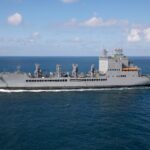
Vice Adm. Michael J. Connor, commander of Navy submarine forces, wants to enhance the conventional deterrent capability of United States submersibles to include the nation’s nuclear and ballistic missile submarines.Connor on May 14 laid out his vision of the future capability of submarines at a forum hosted by the Center for Strategic and International Studies (CSIS). The U.S. must continually improve the capabilities of its submarine forces and at the same time counter the technological advancements of its potential enemies,…

 By
By 











